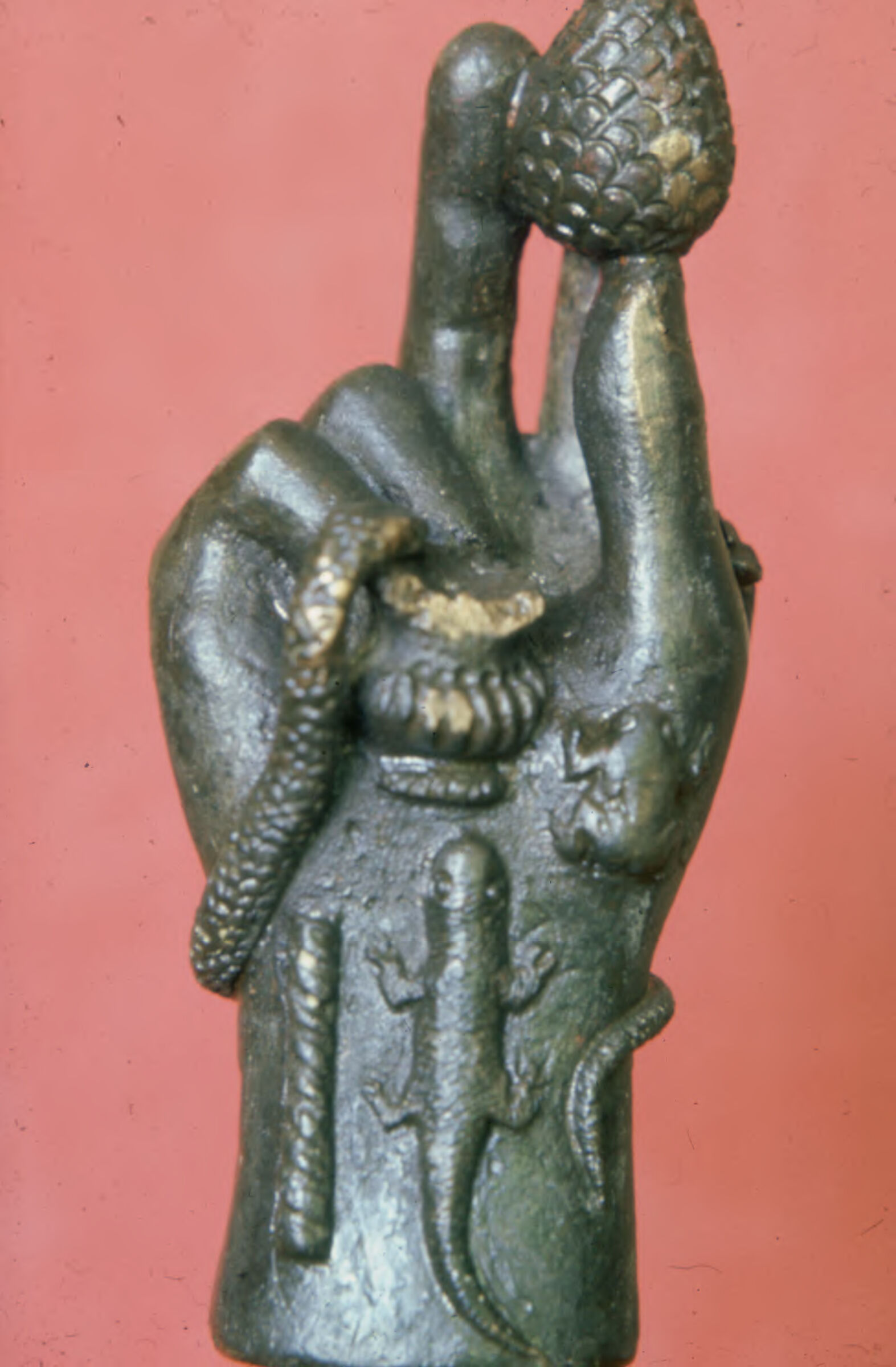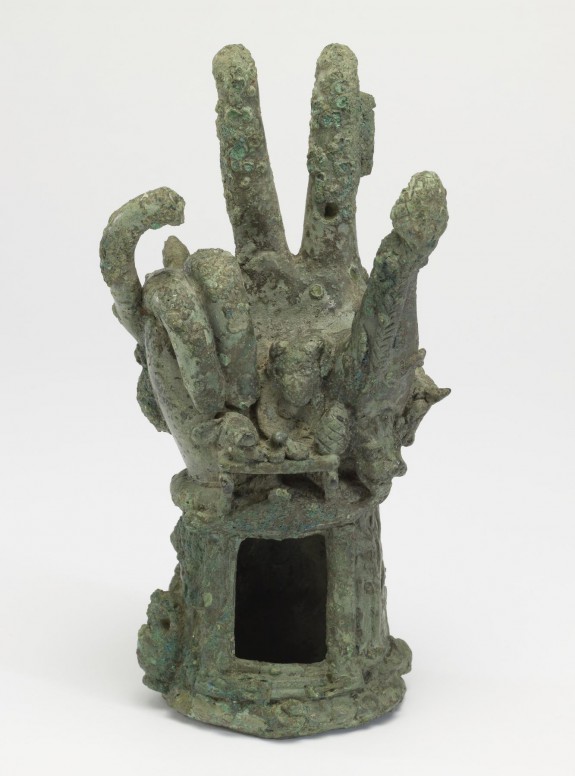Cherries have been around since forever. Cherry stones regularly appear at neolithic sites across Europe and the Middle East. Back in those days of course they were all wild cherries.
The earliest mention of cultivating cherries comes from classical Greece. It's in a book called Enquiry Into Plants by a chap named Theophrastus. Theophrastus was a student of Aristotle (who was in turn taught by Plato, whose teacher was Socrates, who was taught by Diotima.) This puts him about a hundred years after the time of Nico and Diotima.
It's clear from his text that cherry orchards have been around for some time. The dating on the first cherry orchard can be bookended because cherries don't get a mention in Hesiod's book Works and Days. Hesiod is more or less the same date as Homer, and Works and Days is like the archaic Greek version of The Dummy's Guide to Farming. Cultivated cherries probably are a late archaic or a classical creation.
Sabazios
Sabazios sounds like a name that should belong to a composer of classical music, but he is in fact an ancient Phrygian god. The cult of Sabazios made it into Athens some time in the mid-400s BC. Which we know for sure because by the end of the 400s Aristophanes had written a play (now lost) in which Sabazios is ejected from the city.
The odd thing is that although the Athenians were extremely tolerant of other religions, they disliked this particular cult. The orator Demosthenes once attacked a political enemy by claiming he partook in rites to Sabazios. The clear implication was that anyone who worshiped Sabazios was a disreputable crackpot.
Demosthenes also says the rites involved frenzied dancing while holding snakes and chanting, "Euoi saboi! Euoi saboi!"
The -zios part of Sabazios is cognate with the Greek Zeus and the Latin Deus. Despite which, the Greeks associated Sabazios with Dionysos. Herodotus refers to the Phrygians worshipping Dionysos in contexts where he clearly means Sabazios.
The most viable explanation is that in Phrygia, Sabazios was a god of the harvest and of barley in particular, thus probably with beer making. Aristophanes in one of his comedies refers to "the sleep of Sabazios" to mean guardsmen who've drifted off after drinking. While in Athens, Dionysos was the god of the harvest and of wine.
There are problems with this though. Archaic images of what's believed to be Sabazios show him on horseback and carrying a staff, which isn't particularly agricultural. Even well into Roman times, the rites of Sabazios continued to involve orgiastic dancing while holding live snakes. While this sounds like fun, the snakes are not even remotely agricultural.
Finally, every shrine to Sabazios had its own Hand. The Hand was always a sculpture, shown upright, in a pose of benediction that might look familiar to modern church goers. Here are some hands of Sabazios:



These are from the British Museum, Harvard, and the Walters Museum. The Hand of Sabazios usually holds something, an acorn or a snake or sometimes even a small figure.
The odd thing is that although the Athenians were extremely tolerant of other religions, they disliked this particular cult. The orator Demosthenes once attacked a political enemy by claiming he partook in rites to Sabazios. The clear implication was that anyone who worshiped Sabazios was a disreputable crackpot.
Demosthenes also says the rites involved frenzied dancing while holding snakes and chanting, "Euoi saboi! Euoi saboi!"
The -zios part of Sabazios is cognate with the Greek Zeus and the Latin Deus. Despite which, the Greeks associated Sabazios with Dionysos. Herodotus refers to the Phrygians worshipping Dionysos in contexts where he clearly means Sabazios.
The most viable explanation is that in Phrygia, Sabazios was a god of the harvest and of barley in particular, thus probably with beer making. Aristophanes in one of his comedies refers to "the sleep of Sabazios" to mean guardsmen who've drifted off after drinking. While in Athens, Dionysos was the god of the harvest and of wine.
There are problems with this though. Archaic images of what's believed to be Sabazios show him on horseback and carrying a staff, which isn't particularly agricultural. Even well into Roman times, the rites of Sabazios continued to involve orgiastic dancing while holding live snakes. While this sounds like fun, the snakes are not even remotely agricultural.
Finally, every shrine to Sabazios had its own Hand. The Hand was always a sculpture, shown upright, in a pose of benediction that might look familiar to modern church goers. Here are some hands of Sabazios:


These are from the British Museum, Harvard, and the Walters Museum. The Hand of Sabazios usually holds something, an acorn or a snake or sometimes even a small figure.
The teenager's guide to WW1
My teenage daughter's current assignment in her history class is to write a war correspondent report from the trenches of Gallipoli during WW1. While I wouldn't normally stick into this blog anything that was both family and school, I can't resist her first draft; I herewith give you a teenager's take on WW1:
HEY STEFFO!!!
We’re here in this stupid &#^#%@ bay and all about to die L except everyone’s trying to be all honourable and we’re just like meh.
The Turks aren’t very good at aiming coz we’re all still alive.
I miss my teddy bear, and my nice warm bed. Trenches are like SO unfashionable.
Day to day fighting includes the same routine as everywhere else: Aim, fire, shoot, duck. Repeat.
If this telegram is sent you in error please do NOT (repeat NOT) serve it with broccoli. It should instead be lightly stewed for best results add sugar. Thankyou.
Love from
Falshywalshy Official War Idiot Correspondent who volunteered for this (that was dumb o.o)
PS. Someone just died next to me. I suspect oxygen suffocation from laughter.
Your story begins on page 100: a cool critique letter by Robert Heinlein
This might interest the writers among us. The Mote in God's Eye is a very famous SF novel written by Larry Niven and Jerry Pournelle back in 1973. They sent the manuscript to Robert Heinlein to check over. Heinlein's regarded by many as the greatest SF author ever, and at that time he was at the height of his powers.
Heinlein was so fascinated by The Mote in God's Eye that he spent five days reading and critiquing the ms, then he sent back a 17 page letter that clinically pointed out Niven and Pournelle's copious errors.
Quite by accident I discovered Heinlein's critique is online at The Virginia Edition. Virginia was the name of Heinlein's wife and this appears to be a site publishing Heinlein's complete works. In any case the link goes to a PDF sampler that includes the critique. Open the PDF, scroll down to page 15 and start reading.
What struck me is that Heinlein's critique reads much like the best sort of responses that you find within critic groups these days. The difference being that this one's written by one of last century's most successful authors.
There are phrases in there that will resonate with most authors, and will definitely resonate with my literary agent. Phrases such as, "Your story begins on page 100." Heinlein lays into Niven and Pournelle for their poor English (two ultra-respected authors, mind you!). He was a former naval officer and he dissects their naval etiquette in detail. But mostly it's the way he thinks in terms of what makes a book work that I find instructive. Plus these words of sage advice: "Cut, cut, cut."
I'd suggest reading the book first. It's long but will reward you. Then read the critique. You can actually see where Heinlein's advice changed the novel.
The book went on to become a bestseller.
Heinlein was so fascinated by The Mote in God's Eye that he spent five days reading and critiquing the ms, then he sent back a 17 page letter that clinically pointed out Niven and Pournelle's copious errors.
Quite by accident I discovered Heinlein's critique is online at The Virginia Edition. Virginia was the name of Heinlein's wife and this appears to be a site publishing Heinlein's complete works. In any case the link goes to a PDF sampler that includes the critique. Open the PDF, scroll down to page 15 and start reading.
What struck me is that Heinlein's critique reads much like the best sort of responses that you find within critic groups these days. The difference being that this one's written by one of last century's most successful authors.
There are phrases in there that will resonate with most authors, and will definitely resonate with my literary agent. Phrases such as, "Your story begins on page 100." Heinlein lays into Niven and Pournelle for their poor English (two ultra-respected authors, mind you!). He was a former naval officer and he dissects their naval etiquette in detail. But mostly it's the way he thinks in terms of what makes a book work that I find instructive. Plus these words of sage advice: "Cut, cut, cut."
I'd suggest reading the book first. It's long but will reward you. Then read the critique. You can actually see where Heinlein's advice changed the novel.
The book went on to become a bestseller.
Subscribe to:
Posts (Atom)
